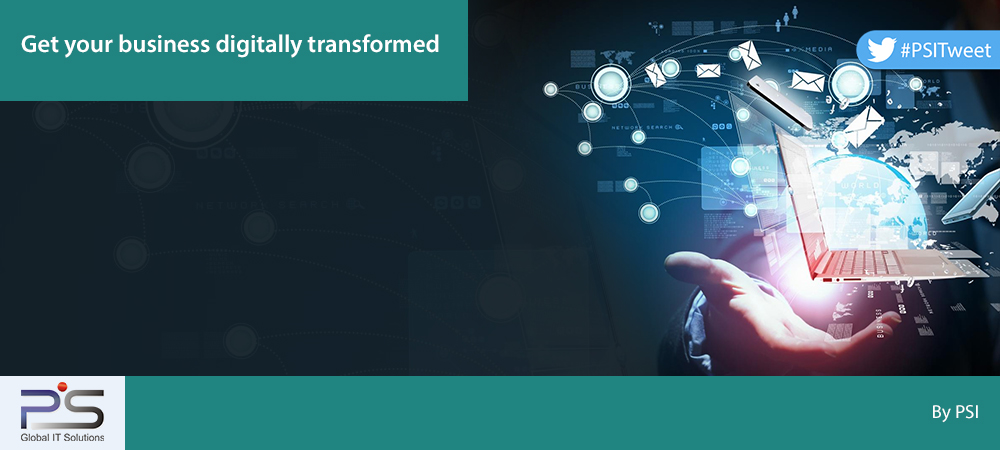Digital transformation is happening today not only across private sector, but also rapidly rampant across public sector offices. This has been found in a recent survey of 537 Harvard Business Review readers of which 45%comprised either executives or senior managers.
Nevertheless, a lot has been spoken about Digital Transformation and Digital Ramification of businesses. What does it really imply and how will it impact the overall growth course of an enterprise?
Digital Transformation literally implies use of technology to radically spur the performance of the business. Speaking literally it means going paperless and connecting via the Digital interface. Organizations are constantly utilizing digital technologies such as Analytics, Mobility, Social Media, IoT to revolutionize customer experience and overall business transformation. Competitors, Customer choices and overall organizational growth are the major reasons that invoke organizations to transform.
Building Blocks of Digital Transformation
Businesses are focusing on three main areas to transform themselves. The blocks can be further segregated into different sub parts and helps achieve the goal of transformation.
- Business Model: A common saying is ‘if you don’t change, you will die.’ The businesses are revamping their traditional setup to include digital services in their portfolio or are opening new channels to digitally serve their clients. In other words, create digitally adaptable businesses. They want to develop an organization, which is centralized and decentralized both at the same time.
- Operational Model: Automation of internal processes results in efficiency and scalability. Self service portals serve the purpose and create a window for innovation and creativity. The issues concerning resource requirements, product quality, environment, health, and safety can be resolved drastically by adopting digital transformation.
- Customer Experience: Understanding changing customer choices is a cumbersome task for any business. Organizations are using data available through external sources as well as internally to chart out the customer satisfaction levels. They focus on social media to have an in depth study about the customer. They create online fellow communities for customers to interact and share their feedback. Through digital media, they can monitor various customer touch points and provide improved experience.
Organizations apply digital technologies for breakthrough, extension and substitution at various levels. The digital blocks transform the organizational blocks into valuable assets and build a progressive pathway for the future.
Digital transformation follows a three-step process:
- Envision the digital future for your organization
- Invest in digital initiatives and skills
- Lead the change
It is not a static process but a self evolving change throughout the organization. This includes creating and communicating business objectives, establishing governance and measurement mechanisms and building a digitally accessible / adaptable organization.
Image Courtesy: http://www.information-age.com/Digital transformation is happening today not only across private sector, but also rapidly rampant across public sector offices. This has been found in a recent survey of 537 Harvard Business Review readers of which 45%comprised either executives or senior managers.
Nevertheless, a lot has been spoken about Digital Transformation and Digital Ramification of businesses. What does it really imply and how will it impact the overall growth course of an enterprise?
Digital Transformation literally implies use of technology to radically spur the performance of the business. Speaking literally it means going paperless and connecting via the Digital interface. Organizations are constantly utilizing digital technologies such as Analytics, Mobility, Social Media, IoT to revolutionize customer experience and overall business transformation. Competitors, Customer choices and overall organizational growth are the major reasons that invoke organizations to transform.
Building Blocks of Digital Transformation
Businesses are focusing on three main areas to transform themselves. The blocks can be further segregated into different sub parts and helps achieve the goal of transformation.
- Business Model: A common saying is ‘if you don’t change, you will die.’ The businesses are revamping their traditional setup to include digital services in their portfolio or are opening new channels to digitally serve their clients. In other words, create digitally adaptable businesses. They want to develop an organization, which is centralized and decentralized both at the same time.
- Operational Model: Automation of internal processes results in efficiency and scalability. Self service portals serve the purpose and create a window for innovation and creativity. The issues concerning resource requirements, product quality, environment, health, and safety can be resolved drastically by adopting digital transformation.
- Customer Experience: Understanding changing customer choices is a cumbersome task for any business. Organizations are using data available through external sources as well as internally to chart out the customer satisfaction levels. They focus on social media to have an in depth study about the customer. They create online fellow communities for customers to interact and share their feedback. Through digital media, they can monitor various customer touch points and provide improved experience.
Organizations apply digital technologies for breakthrough, extension and substitution at various levels. The digital blocks transform the organizational blocks into valuable assets and build a progressive pathway for the future.
Digital transformation follows a three-step process:
- Envision the digital future for your organization
- Invest in digital initiatives and skills
- Lead the change
It is not a static process but a self evolving change throughout the organization. This includes creating and communicating business objectives, establishing governance and measurement mechanisms and building a digitally accessible / adaptable organization.
Image Courtesy: http://www.information-age.com/[:]









